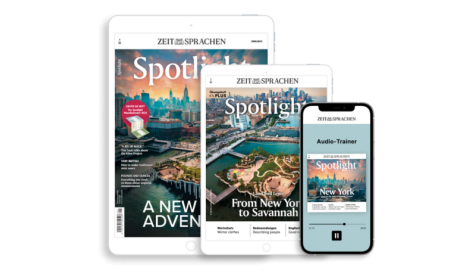Starten Sie den Audio-Text
Mit dem Audio-Player können Sie sich den Text anhören. Darunter finden Sie das Transkript.
Transcript: Edinburgh Fringe Festival
Every August, the city of Edinburgh explodes in an extravaganzaSpektakelextravaganza of diverse performances from every conceivableerdenklichconceivable genre of the arts. I’m talking about the Edinburgh Fringe Festival, which is the largest arts festival in the world. From humblebescheiden; hier: einfachhumble street performers to acclaimedgefeiertacclaimed international artists, this three-week-long festival has something for everybody. The Edinburgh Festival Fringe Society was set up to support the artists, sell tickets and provide information to the public. To learn more about what this involves, listen now to an interview with the organisation’s CEO (chief executive officer)Geschäftsführer(in)CEO, Shona McCarthy.
In the first part of the interview, Shona explains how she got involved with the Fringe Society.
So, I’m Shona McCarthy. I’m the chief executive of the Edinburgh Festival Fringe Society, and I came to Edinburgh quite simply because I’ve always loved the Edinburgh Fringe and looked at it from afar: from ~aus der Ferneafar with some level of envyNeidenvy and aspirationStreben; hier: Zielaspiration, if the truth be told. But I’m originally from Northern Ireland, worked in Belfast and in Derry for many years, and most recently headed up the first UK City of Culture, which was in Derry/Londonderry. So yeah, that’s where I grew up, worked in the cultural sector for, you know, 25 years. And then one December, I think three different friends e-mailed me saying, “Have you seen the Edinburgh Fringe are looking for a new chief executive?” And then eventuallyschließlich, irgendwanneventually the Fringe Society themselves e-mailed me to say, you know, “We’d like to draw your attention to this role”. And so that was an irresistibleunwiderstehlichirresistible opportunity, and I applied for the job, got the job, and have been in Edinburgh for seven years now, and loved every minute of it.
The Edinburgh Fringe Festival was established in 1947 as an alternative to the Edinburgh International Festival. Both festivals take place at the same time every August, but unlike the International Festival, which focusses on bringing together top-class artists from the fields of classical music, theatre, opera and dance, the Fringe Festival is open to all performers. It does not have a selection committee, and anyone who can book a venue(Veranstaltungs)Ortvenue can perform.
People don’t often understand that the Edinburgh Fringe is an open-access festival and the best way to describe that is, for me, it’s a bit like YouTube only it’s live performance. So, we basically provide a platform across the city and anyone who can find a venue can be part of the Fringe and register to be part of the Fringe. And that can be music, drama, circus, cabaret, spoken word, street performance, theatre, contemporary dance. It can be any art form. And so, there’s no single one curator or programmer who selects work to be on the Fringe. It’s largely an uncurated festival, and so I’m not the chief executive of the festival, I’m the chief executive of the charitable organization, the Edinburgh Festival Fringe Society, that was set up back in 1958 to provide some coherenceZusammenhalt, Geschlossenheitcoherence and coordination to what would otherwise have been thousands of micro-enterprises and small moving parts.
With around 3,000 shows scheduled for the 2023 Edinburgh Fringe, it’ll be a challenge to decide what to see. What advice would Shona McCarthy give to someone visiting the festival for the first time?
For the first time visitor, it can be dauntingeinschüchternddaunting. My advice to them would be get the programme in advance. Because the fringe is so big, it’s a great way and it’s sectioned into comedy, music, drama, so you can really filter and you can do this on the website and the app as well. You can really filter down to what is it: Is it comedy? Is it Irish comedy? I would say that, wouldn’t I? You know, you can filter down to, you know, the selection of Irish comedians. Then you can filter by budget and say, you know, I don’t want to pay more than eight pounds for a ticket. So, you might look at the Free Fringe, which is a kind of a “pay what you want at the end of the show”. You might look at that kind of mid-range of fringe venues. The bigger venues and the bigger names, you’re going to probably pay a bit more for a ticket, but still, generally speaking, under 20 pounds. So, for the audience, I would say there’s lots of tools there. Use the tools, but also it can be just really fun to take a flyer from an artist on the street and go, “You know what? I’m just going to have a punt: have a ~ (ifml.)etw. riskieren, ausprobierenpunt,” because sometimes you can see something extraordinary. Sometimes you can see something absolutely dreadful, but that can also be part of your fringe experience and can be a real talking point.
Neugierig auf mehr?
Dann nutzen Sie die Möglichkeit und stellen Sie sich Ihr optimales Abo ganz nach Ihren Wünschen zusammen.



